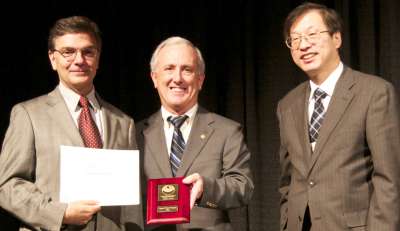Station Papa / Line-P PICES Ocean Monitoring Service Award (POMA) – PICES 2010 POMA Award
 Dr. William Crawford (left) accepting the POMA from
Dr. John Stein (center, PICES Science Board Chairman)
and Dr. Tokio Wada (right, PICES Chairman)
Dr. William Crawford (left) accepting the POMA from
Dr. John Stein (center, PICES Science Board Chairman)
and Dr. Tokio Wada (right, PICES Chairman)
Photo Album
PICES Press (201, Vol. 19, No. 11)
At the 2010 PICES Annual Meeting in Portland, OR, U.S.A., it was announced that the Station Papa / Line-P monitoring program was the recipient of the 3rd POMA Award. The presentation ceremony took place on October 25, 2010, during the PICES-2010 Opening Session and was conducted by Drs. Tokio Wada (PICES Chairman) and John Stein (PICES Science Board Chairman). A commemorative plaque and a certificate were presented to Dr. William Crawford (Head of the State of the Ocean section at the Institute of Ocean Sciences at Fisheries and Oceans Canada) who accepted the award on behalf of the thousands of people, past and present, who contributed to the Station Papa/Line-P monitoring program for the past six decades.
Science Board citation for the 2010 POMA Award
The PICES Ocean Monitoring Service Award (POMA) was established to recognize organizations, groups and outstanding individuals that have contributed significantly to the advancement of marine science in the North Pacific through long-term ocean monitoring, data management and communication. And it is with great pleasure for me to announce that the 2010 POMA award goes to the Station Papa/Line-P monitoring program.
The seeds that grew into Line-P were sown during the Second World War. With the increase in the number of trans-Pacific flights, there was a need to monitor marine weather systems in the North Pacific. In 1943, the first vessel to occupy Station Peter, as it was then known, was the U.S. Coast Guard cutter Haida, and since then many ships have occupied Line-P and Station Papa. The first hydrographic casts at the station began in 1959, and this was the start of Line-P observations. And for the past 60 years, Ocean Station Papa and Line-P have contributed to the region’s only multi-decadal time series of oceanographic conditions for the Northeast Pacific Ocean. Today, the Line-P oceanographic sampling program is comprised of 27 hydrographic stations leading to Station Papa, and forms the backbone for cutting-edge, multi-disciplinary research on ocean dynamics, biology and chemistry.
Throughout its history, the rich data provided by this unique monitoring program have given scientists around the world opportunities to revolutionize the field of ocean science and participate in international projects that probe today’s most pressing challenges in the physics, biology and chemistry of the ocean—including studies of El Niño, ocean storms, and iron enrichment. The long-term surveys along Line-P have also served as an integral component of global reports on the dynamics and status of our oceans, as well as a training ground for the next generation of oceanographers who have completed (or someday imagine completing) graduate research degrees on Line-P.
The Line-P archive provides a unique picture of the mean state in one part of our global oceans, and has proven critical in developing our ideas of how the ocean evolves. There are far too many people involved in this monitoring program to list. But there are managers who have ensured excellence in ocean sampling along Line-P. In chronological order, they are John P. Tully to whom we owe the original concept, Sus Tabata who years ago showed the power of a long time series, Frank Whitney who managed the program as it expanded to become a training ground for students and PhD theses, and finally, Marie Robert, who is presently juggling the myriad of demands from many universities and other research laboratories.
Please join me in congratulating Dr. Bill Crawford, Head of the State of the Ocean section at the Institute of Ocean Sciences at Fisheries and Oceans Canada, who is receiving the 2010 POMA Award on behalf of the thousands of people, past and present, who contributed to the Station Papa/Line-P monitoring program for the past six decades. Their sustained efforts, extraordinary vision, and dedicated leadership have built an invaluable resource that captures the changing biophysical conditions of the North Pacific and have had a profound impact on the development of ocean science.
Dr. Crawford's acceptance remarks
Thank you, Drs. Wada and Stein. What a surprising and amazing honor! I am especially humbled given the outstanding scientific talent in the PICES community and that represented by the previous awardees. This award is especially significant to me for several reasons. In the late 1980s, we observed ecosystem changes in the Hawaiian Archipelago and invited Dr. Wooster to Hawaii to help us develop a research program to understand those changes. Thus, Dr. Wooster's guidance helped shape the direction of much of my subsequent research on decadal variation. Secondly, while much of my research focuses on the subtropical ecosystem south of the PICES geographic area of interest, the PICES community represents my intellectual home. Its approach of addressing large spatial-scale dynamics, physical-biological linkages, and complete ecosystems has always had great appeal to me. Lastly, I would like to acknowledge that my achievements are the result of contributions from many wonderful colleagues, mentors, and co-authors, and I am truly grateful to the collaborations over many years with the talented staff of the Ecosystems and Oceanography Division of the Pacific Islands Fisheries Science Center.